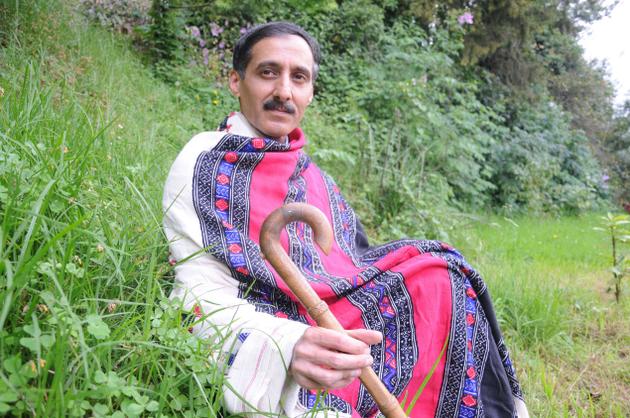
The year was 1990. A youth in his mid-20s was browsing through books at the Defence Services Staff College library in Wellington, when he chanced upon WHR Rivers’ The Todas. As the son of an Army officer who served in the Nilgiris for long and as a student of The Lawrence School, Lovedale, he was familiar with name Todas, but knew nothing more. The pictures and text in the book fascinated him. It spoke about the Toda rites of passage, their rituals and way of life. He got it reissued repeatedly till he was satisfied he had read it thoroughly.
Today, Ooty-based dentist, 49-year-old Tarun Chhabra, is an expert on Toda culture and is possibly one of the few outsiders who can speak their language fluently.
The transformation took time. Tarun read up some more and introduced himself to the Todas. To learn their language, he wrote down words in a notebook and memorised them. Many months later, his vocabulary stood at a mere 50 words. Then, he threw his notebook away. He learnt to speak. “There was a time when I spoke a language that was 95 per cent Tamil and five per cent Toda. Now, it’s nearly 100 per cent Toda,” he smiles.
Tarun says his life has been enriched by the Todas. “Their culture and traditions are unique, and I feel privileged to have experienced them first-hand,” he says.
THE WORLD HEREAFTER
One of the Todas’ main beliefs relates to the afterlife. When a clan member dies, a buffalo is sacrificed. It is believed the animal will accompany the soul to the after world, passing though 15 landmarks. “Once, Kwattawdr Kuttan, a clan leader, took me to Upper Bhavani to show me the landmarks. They actually existed. That brought alive the belief for me. It was an honour, considering he had not even taken his son to the place,” says Tarun. Incidentally, buffalo sacrifice is on the wane these days, with many settling for a symbolic sacrifice.
Tarun has also joined in the community task of thatching the revered conical temple. He accompanied the tribesmen to the western slopes of the Nilgiri rainforest to collect rattan cane for the job.
Today, the Toda way of life is at a crossroads with just about 1,400 traditional tribespeople left. The Toda Nalavaaazhvu Sangam, set up by Tarun in 1992, primarily works to preserve their culture and provide better healthcare. It has got munds electrified. It has rebuilt abandoned temples and migration hamlets where the pastoral tribesmen stay when they take their cattle grazing. When buffalos are killed by predators, the trust compensates the Todas with another buffalo so that livelihoods are not affected.
Tarun is so much in tune with the tribe, there’s little trace of his former avatar. He’s turned vegetarian and there are no religious symbols at home. Toda motifs reign — photographs of the temple, paintings of Todas or samples of Toda embroidery. Suzana, his assistant at the clinic, laughs: “He does not watch television or use a cell phone. He still depends on the radio.”
Tarun has also set up an NGO, Edhkwehlynawd Botanical Refuge Centre Trust (http://www.ebr.org.in/), to conserve the flora and fauna of the land and to re-establish native species and to study the fauna of the area. “The idea is to restore the local ecology to its original condition,” says Tarun, who is also a photographer.
He has rich knowledge of local flora and fauna, thanks to the Todas. “A bulk of my basic botanical knowledge is from them. I first say the Toda name, the botanical name and then the local name!”
READING NATURE
The Todas live a life attuned to Nature, a fact that Tarun deeply admires. For instance, they know the South West monsoon is on its way out when the Mawrsh (Michelia nilagirica or Nilgiri champak) flowers bloom. “They even have a flower that I call the worry flower,” smiles Tarun. “They believe that if you pluck the arkil poof (Gentiana pedicellata) by its stem and hold it, and it closes, you are worried. What a lovely way to gauge happiness!”
During one such botanical expedition with Kwattawdr Kuttan in Kudiakad Betta, Tarun sighted a white rhododendron. It has since been named after him: Rhododendron arboreum nilagiricum tarun.
Tarun, who’s as comfortable in a puthukuli, the traditional Toda shawl, as he is in a dapper suit, says he feels blessed. Despite being an outsider, he got to experience the life of the Todas at such close quarters, and even shared their home, an honour bestowed upon few. But, that’s probably because they consider him one of them. He reciprocates.
Treatment for Todas is always free at this dental clinic. One of his most memorable meetings was with Taihthilly Kuttan, who came to his clinic for a check-up. They spoke of the issues plaguing the tribe, when the elder said: “You will know our problem. After all, you are like a Toda. No, no, you ARE a Toda!”
Now, Tarun lives close by the Kizhker mund (Miniki Mund) near Fernill, on the foothills of Cairn Hill. His house is called Kewlngod, the Toda name for Cairn Hill. Tarun’s garden teems with native shola species, a spot of wilderness in new-age Ooty. He wakes up every morning to the sight of the mund in the near distance. He’s outside, yet a part of them.
source: http://www.thehindu.com / The Hindu / Home> Features> MetroPlus> Society / by Subha J Rao / Coimbatore – October 17th, 2013
